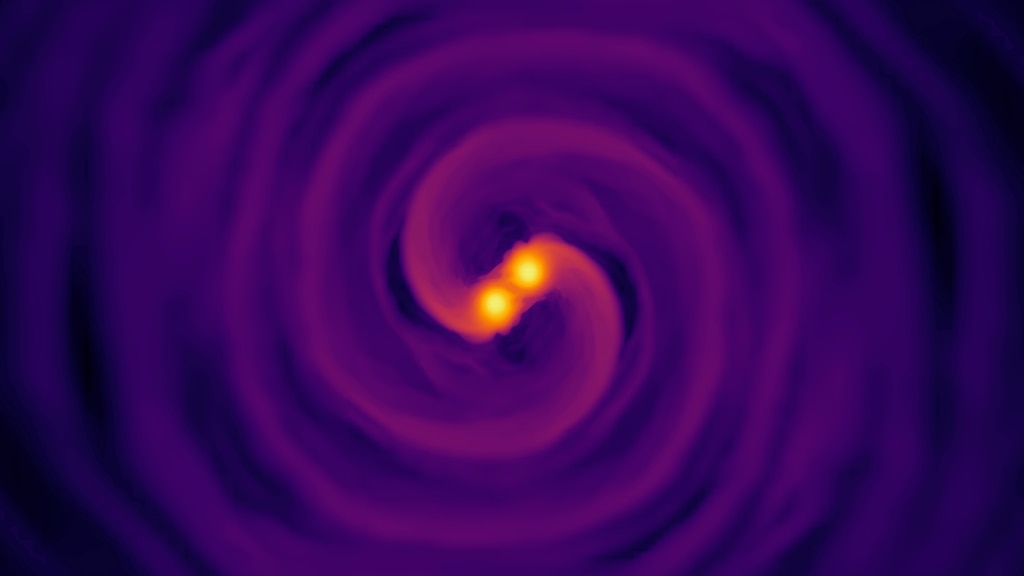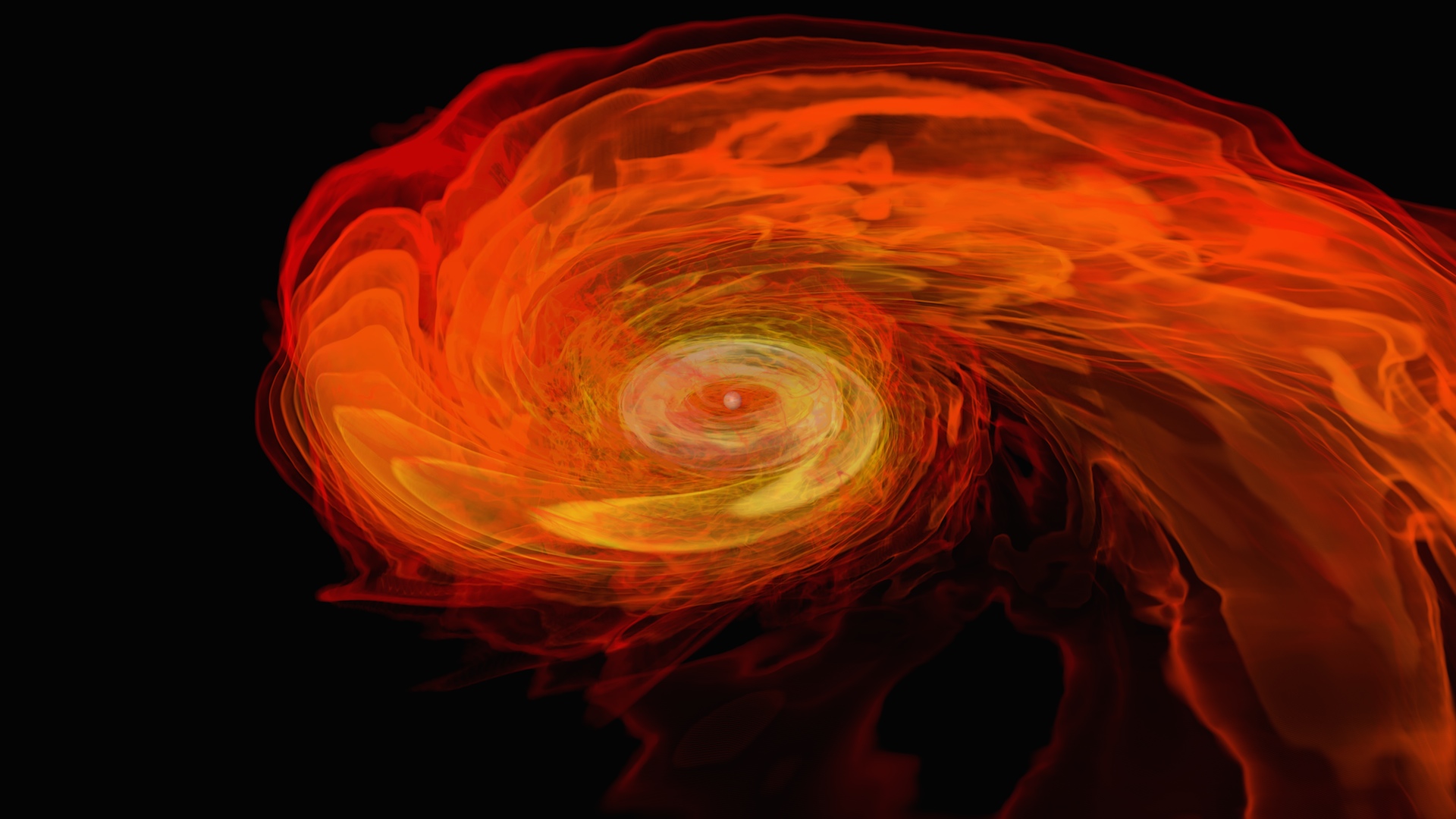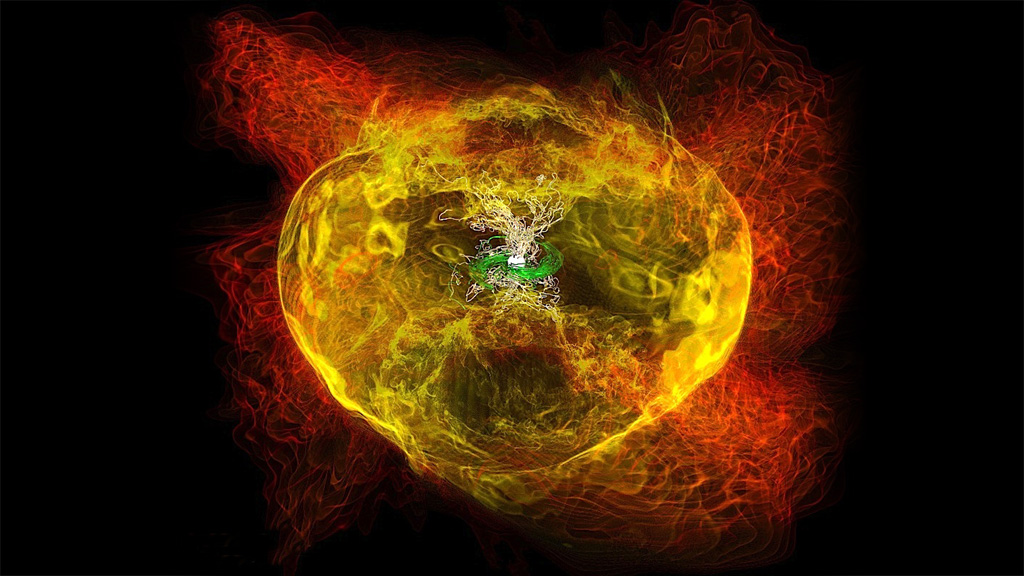When Neutron Stars Collide
Armed with state-of-the-art supercomputer models, scientists have shown that colliding neutron stars can produce the energetic jet required for a gamma-ray burst. Earlier simulations demonstrated that mergers could make black holes. Others had shown that the high-speed particle jets needed to make a gamma-ray burst would continue if placed in the swirling wreckage of a recent merger.
Now, the simulations reveal the middle step of the process—how the merging stars' magnetic field organizes itself into outwardly directed components capable of forming a jet. The Damiana supercomputer at Germany's Max Planck Institute for Gravitational Physics needed six weeks to reveal the details of a process that unfolds in just 35 thousandths of a second—less than the blink of an eye.
For the researchers' website, with more video and stills of their simulations, go here.
State-of-the-art supercomputer models show that merging neutron stars can power a short gamma-ray burst.
For complete transcript, click here.

These images show the merger of two neutron stars recently simulated using a new supercomputer model. Redder colors indicate lower densities. Green and white ribbons and lines represent magnetic fields. The orbiting neutron stars rapidly lose energy by emitting gravitational waves and merge after about three orbits, or in less than 8 milliseconds. The merger amplifies and scrambles the merged magnetic field. A black hole forms and the magnetic field becomes more organized, eventually producing structures capable of supporting the jets that power short gamma-ray bursts. Credit: NASA/AEI/ZIB/M. Koppitz and L. Rezzolla

No Labels version. Credit: NASA/AEI/ZIB/M. Koppitz and L. Rezzolla
Video of simulation showing density on left and magnetic field on right. It pauses and rotates around the black hole at the center. Credit: NASA/AEI/ZIB/M. Koppitz and L. Rezzolla
Video of simulation showing density on left and magnetic field on right. Credit: NASA/AEI/ZIB/M. Koppitz and L. Rezzolla

Merger simulation at 0 milliseconds. No Labels. Credit: NASA/AEI/ZIB/M. Koppitz and L. Rezzolla

Merger simulation at 7.4 milliseconds. No Labels. Credit: NASA/AEI/ZIB/M. Koppitz and L. Rezzolla

Merger simulation at 13.8 milliseconds. No Labels. Credit: NASA/AEI/ZIB/M. Koppitz and L. Rezzolla

Merger simulation at 15.26 milliseconds. No Labels. Credit: NASA/AEI/ZIB/M. Koppitz and L. Rezzolla

Merger simulation at 21.2 milliseconds. No Labels. Credit: NASA/AEI/ZIB/M. Koppitz and L. Rezzolla

Merger simulation at 26.5 milliseconds. No Labels. Credit: NASA/AEI/ZIB/M. Koppitz and L. Rezzolla

Merger simulation showing magnetic fields at 13.8 milliseconds. Credit: NASA/AEI/ZIB/M. Koppitz and L. Rezzolla

Merger simulation showing magnetic fields at 15.26 milliseconds. Credit: NASA/AEI/ZIB/M. Koppitz and L. Rezzolla

Merger simulation showing magnetic fields at 21.2 milliseconds. Credit: NASA/AEI/ZIB/M. Koppitz and L. Rezzolla

Merger simulation showing magnetic fields at 26.5 milliseconds. Credit: NASA/AEI/ZIB/M. Koppitz and L. Rezzolla
Credits
Please give credit for this item to:
NASA/Goddard Space Flight Center. However, each image should be credited as indicated above.
-
Science writer
- Francis Reddy (University of Maryland College Park)
-
Producer
- Scott Wiessinger (UMBC)
-
Graphics
- Francis Reddy (University of Maryland College Park)
-
Animators
- Dana Berry (Skyworks Digital)
- Walt Feimer (HTSI)
- Chris Smith (HTSI)
- Cruz deWilde (Avant Gravity)
- Chris Meaney (HTSI)
-
Video editor
- Scott Wiessinger (UMBC)
-
Narrator
- Erin McKinley (OSU)
-
Scientists
- Bruno Giacomazzo (University of Maryland)
- Luciano Rezzolla (AEI)
-
Writer
- Scott Wiessinger (UMBC)
Release date
This page was originally published on Thursday, April 7, 2011.
This page was last updated on Wednesday, August 14, 2024 at 10:44 PM EDT.
Missions
This page is related to the following missions:Series
This page can be found in the following series:Tapes
The media on this page originally appeared on the following tapes:-
When Neutron Stars Collide
(ID: 2011035)
Thursday, April 7, 2011 at 4:00AM
Produced by - Robert Crippen (NASA)


